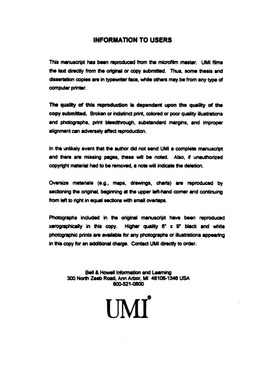| dc.contributor.advisor | Mock, D. W., | en_US |
| dc.contributor.advisor | Schwagmeyer, P. L., | en_US |
| dc.contributor.author | Whitekiller, Robin Rae. | en_US |
| dc.date.accessioned | 2013-08-16T12:30:57Z | |
| dc.date.available | 2013-08-16T12:30:57Z | |
| dc.date.issued | 2000 | en_US |
| dc.identifier.uri | https://hdl.handle.net/11244/5990 | |
| dc.description.abstract | In addition, I looked at another aspect of the reproductive biology of the House Sparrow, the effects of ectoparasites on nestling growth, parental provisioning and reproductive success. To determine whether Pellonyssus reedi, a haematophagous mite, affects offspring growth and fledging success, I compared mass, tarsus length, wing length, duration of the nestling period, and fledging success for nestlings in nests treated with a pesticide to that of young in control nests. To evaluate the effect of P. reedi on parental provisioning, I compared the total number of feeding visits, sizes of prey delivered, and divisions of parental workloads between treatments. Nestlings in pesticide-treated nests had, on average, greater mass and tarsus lengths than nestlings in control nests. Nestlings in pesticide-treated nests also tended to have longer wings. Duration of the nestling period did not differ between the two treatments. I also found no effect on fledging success. Neither total parental feeding rate nor mean prey size delivered differed between treatments, but male parents tended to do a greater share of nestling provisioning at pesticide-treated nests. | en_US |
| dc.description.abstract | I used DNA fingerprinting to examine paternity in the House Sparrow and found that 20% of the offspring were attributable to extra-pair fertilizations (EPFs). I examined the distribution of extra-pair offspring among broods. I then examined extra-pair paternity and male mate-guarding in relation to male attractiveness, breeding synchrony, and density. Some males were more likely to be cuckolded than others. Parentage analyses further revealed that males that spent more time mate-guarding had more extra-pair offspring in their nests. Male badge size was unrelated to both paternity and mate-guarding duration. Heavier males tended to spend less time in proximity to their mates. Moreover, heavier males tended to be cuckolded less than smaller males. Density was somewhat predictive of whether a male would be cuckolded; however, I did not find a relationship between breeding synchrony and the incidence of EPFs. Mate-guarding was not correlated with either density or synchrony, but males tended to guard more intensively when their nearest male neighbor was likely to be engaged in sexual display. | en_US |
| dc.format.extent | viii, 88 leaves : | en_US |
| dc.subject | Birds Breeding. | en_US |
| dc.subject | English sparrow. | en_US |
| dc.subject | Biology, Zoology. | en_US |
| dc.subject | Biology, Ecology. | en_US |
| dc.title | Correlates of extra-pair paternity and the effects of ectoparasites on nestling growth, parental provisioning and reproductive success in the house sparrow. | en_US |
| dc.type | Thesis | en_US |
| dc.thesis.degree | Ph.D. | en_US |
| dc.thesis.degreeDiscipline | Department of Biology | en_US |
| dc.note | Source: Dissertation Abstracts International, Volume: 61-06, Section: B, page: 2871. | en_US |
| dc.note | Major Professors: P. L. Schwagmeyer; D. W. Mock. | en_US |
| ou.identifier | (UMI)AAI9975793 | en_US |
| ou.group | College of Arts and Sciences::Department of Biology | |
